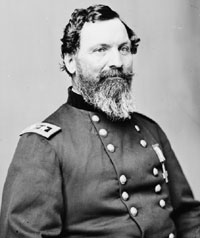 Sedgwick was born in the Berkshires town of Cornwall Hollow, Connecticut. He was named for his grandfather, a Revolutionary War general who served with George Washington.
Sedgwick was born in the Berkshires town of Cornwall Hollow, Connecticut. He was named for his grandfather, a Revolutionary War general who served with George Washington.
John Sedgwick (1813-1864)
John Sedgwick (September 13, 1813 - May 9, 1864) was a teacher, a career military officer, and a Union Army general in the American Civil War.
 Sedgwick was born in the Berkshires town of Cornwall Hollow, Connecticut. He was named for his grandfather, a Revolutionary War general who served with George Washington.
Sedgwick was born in the Berkshires town of Cornwall Hollow, Connecticut. He was named for his grandfather, a Revolutionary War general who served with George Washington.
After teaching for two years, he attended the U.S. Military Academy, graduated in 1837, and was commissioned a lieutenant in the U.S. artillery. He fought in the Seminole Wars and received two brevet promotions in the Mexican-American War, to captain for Contreras and Churubusco, and to major for Chapultepec.
After returning from Mexico he transferred to the cavalry and served in Kansas, in Utah against the Mormon uprising, and in the Indian Wars.
At the start of the Civil War, he served as a colonel and Assistant Inspector General of the Military Department of Washington. He missed the early action of the war at the First Battle of Bull Run, recovering from cholera. Promoted to brigadier general on August 31, 1861, he commanded the 2nd brigade of Samuel P. Heintzelman's division in the Army of the Potomac, then his own division, which was designated the 2nd division of the II Corps for the Peninsula Campaign. In Virginia he fought at Yorktown and Seven Pines and was wounded in the arm and leg at the Battle of Glendale. He was promoted to major general on July 4, 1862.
In the Battle of Antietam, II Corps commander Maj. Gen. Edwin V. Sumner impulsively sent Sedgwick's division in a mass assualt without proper reconnaissance. His division was struck by Confederate forces under "Stonewall" Jackson from three sides, resulting in 2,200 casualties. Sedgwick himself was hit by three bullets, in the wrist, leg, and shoulder, and was out of action until after the Battle of Fredericksburg.
From December 26, 1862, he briefly led the II Corps and the IX Corps, and then finally the VI Corps of the Army of the Potomac, which he commanded until his death in 1864. During the Battle of Chancellorsville, his corps faced Fredericksburg in an initial holding action while Joseph Hooker's other four corps maneuvered against Robert E. Lee's left flank. He was slow to take action, but eventually crossed the Rappahannock River and assaulted Jubal Early's small force on Marye's Heights. Moving west slowly to join forces with Hooker and trap Lee between the halves of the army, he was stopped by portions of Lee's Second Corps (under Maj. Gen. J.E.B. Stuart, following the death of Jackson) at the Battle of Salem Church, forcing his eventual retreat back over the Rappahannock.
At the Battle of Gettysburg, his corps was in reserve and saw no action. In the 1864 Overland Campaign, the VI Corps was on the Union right at the Battle of the Wilderness and defended against assaults by Maj. Gen. Richard S. Ewell's Second Corps.
Sedgwick fell at the beginning of the Battle of Spotsylvania Court House, on May 9, 1864. His corps was probing skirmish lines ahead of the left flank of Confederate defenses and he was directing artillery placements. Confederate sharpshooters were about 1,000 yards away and their shots caused members of his staff and artillerymen to duck for cover. Sedgwick strode around in the open and was quoted (Foote, 1974) as saying, "What? Men dodging this way for single bullets? What will you do when they open fire along the whole line? I am ashamed of you. They couldn't hit an elephant at this distance." Although ashamed, his men continued to flinch and he repeated, "I'm ashamed of you, dodging that way. They couldn't hit an elephant at this distance." Just minutes later he fell forward with a bullet hole below his left eye. He was the highest ranking Union casualty (the most senior by date of rank of all major generals killed) of the Civil War.
Sedgwick's reputation was that of a solid, dependable, but relatively unaggressive general. He was well-liked by his soldiers, who referred to him affectionately as "Uncle John". His death was met by universal sorrow; even Robert E. Lee expressed his sadness over the fate of an old friend. George G. Meade wept at the news. Ulysses S. Grant characterized Sedgwick as one who "was never at fault when serious work was to be done" and he told his staff that the loss for him was worse than that of an entire division.
John Sedgwick is buried near his birthplace of Cornwall Hollow, Connecticut. An equestrian statue honors him and the VI Corps at Gettysburg National Military Park.